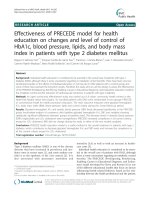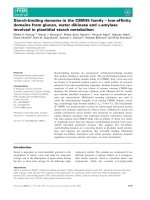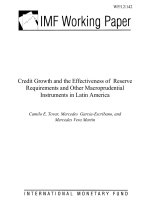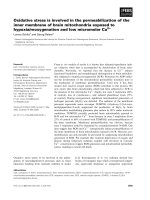Blood gas analyses and other components involved in the acid–base metabolism of rats infected by Trypanosoma evansi
Bạn đang xem bản rút gọn của tài liệu. Xem và tải ngay bản đầy đủ của tài liệu tại đây (400.04 KB, 4 trang )
Journal of Advanced Research (2015) 6, 1079–1082
Cairo University
Journal of Advanced Research
SHORT COMMUNICATION
Blood gas analyses and other components involved
in the acid–base metabolism of rats infected by
Trypanosoma evansi
Matheus D. Baldissera a,b,*, Rodrigo A. Vaucher a, Camila B. Oliveira b,
Virginia C. Rech c, Michele R. Sagrillo a, Daniel R. Stainki b, Raqueli T. Franc¸a d,
Gustavo Machado e, Sonia T.A. Lopes d, Silvia G. Monteiro b, Lenita M. Stefani f,
Aleksandro S. Da Silva f
a
Centro Universita´rio Franciscano, Santa Maria, RS, Brazil
Department of Microbiology and Parasitology, Universidade Federal de Santa Maria (UFSM), Santa Maria, RS, Brazil
c
Laboratory of Nanotechnology, Centro Universita´rio Franciscano, Santa Maria, RS, Brazil
d
Department of Small Animals, Universidade Federal de Santa Maria, Brazil
e
Laboratory of Veterinary Epidemiology, Faculty of Veterinary, Federal University of Rio Grande do Sul (UFRGS), Porto
Alegre, RS, Brazil
f
Department of Animal Science, Universidade do Estado de Santa Catarina (UDESC), Chapeco´, SC, Brazil
b
A R T I C L E
I N F O
Article history:
Received 29 August 2014
Received in revised form 2 December
2014
Accepted 3 December 2014
Available online 9 December 2014
Keywords:
‘‘Surra’’
Arterial blood gases
Pathology
Protozoan
A B S T R A C T
The aim of this study was to investigate the effects of Trypanosoma evansi infections on arterial
blood gases of experimentally infected rats. Two groups with eight animals each were used;
group A (uninfected) and group B (infected). Infected animals were daily monitored through
blood smears that showed high parasitemia with 30 trypanosomes per field (1000·) on average,
5 days post-infection (PI). Arterial blood was collected at 5 days PI for blood gas analysis using
an automated method based on dry-chemistry. Hydrogen potential (pH), partial oxygen pressure (pO2), oxygen saturation (sO2), sodium (Na), ionic calcium (Ca ionic), chlorides (Cl), partial dioxide carbon pressure (pCO2), base excess (BE), base excess in the extracellular fluid
(BEecf), bicarbonate (cHCO3), potassium (K), lactate, and blood total dioxide the carbon
(tCO2) were evaluated. The levels of pH, pCO2, BE, BEecf, cHCO3, and tCO2 were significantly
decreased (P < 0.05) in group B compared to group A. Additionally, the same group showed
increases in Cl and lactate levels when compared to uninfected group. Therefore, it is possible
* Corresponding author. Tel.: +55 55 32208958.
E-mail address: (M.D. Baldissera).
Peer review under responsibility of Cairo University.
Production and hosting by Elsevier
/>2090-1232 ª 2014 Production and hosting by Elsevier B.V. on behalf of Cairo University.
1080
M.D. Baldissera et al.
to state that the infection caused by T. evansi led to alterations in the acid–base status, findings
that are correlated to metabolic acidosis.
ª 2014 Production and hosting by Elsevier B.V. on behalf of Cairo University.
Introduction
Trypanosoma evansi, the etiological agent of a disease known
as ‘‘Surra’’ or ‘‘Mal das Cadeiras’’ in horses, is a hemoflagellate
with wide geographic distribution in tropical and subtropical
regions [1–3]. The parasite is transmitted primarily by blood
sucking insects and possibly by vampire bats [4]. In horses,
dogs, and camels the disease progresses to death, except in rare
cases. The main clinical signs of the disease include: fever, anemia, swollen lymph nodes, jaundice, weight loss, and edema of
hind limbs. Horses, cats, and rats show progressive weakness
and motor disorders at chronic stages of the disease [5,6]. Rats
infected by T. evansi without treatment usually die within 4–
6 days post-infection (PI), and usually show seizures, few
hours before death [7].
One of the main pathological findings in animals infected
by T. evansi is anemia [3,6,7], which can lead to major changes
in blood, as well as acid–base imbalance [8]. Acid–base disturbances are commonly observed in many infections and metabolic disorders, drawing the attention to the need of a
precise description of these disorders in humans and animals
[8]. The arterial blood gas determination plays an important
role in diagnosing acid–base status disturbances, oxygenation,
and ventilation [9]. Therefore, the aim of this study was to
assess the levels of blood gases and other components involved
in the metabolic acid–base status during an acute infection in
rats experimentally infected by T. evansi.
Material and methods
T. evansi). The infection was induced intraperitoneally with
0.1 mL of blood from rat (R1) containing 2.7 · 106 trypanosomes (Day 0).
Parasitemia evolution and sampling
The rats were observed during 5 days with the evolution of
parasitemia monitored daily through blood smears. For this
procedure, each slide was prepared with fresh blood collected
from the tail vein, stained by the panoptic method, and visualized at a magnification of 1000· according to the methodology
described by Da Silva et al. [11]. On day 5 PI the animals were
anesthetized in a chamber with isoflurane for blood sampling
(an average of 7 mL per animal by intra-cardiac puncture of
the left ventricle) using syringes of 0.7 · 25 mm and 22 gauge
needles (BD Preset EclipseÒ). A part of the blood was stored
in tubes with ethylenediamine tetraacetic acid (EDTA) for
hematological analyses and other part was stored in sodium
fluoride for lactate and gas analyses. All analyses were immediately performed using fresh samples. After collection, the
animals were decapitated as recommended by the Ethics
Committee.
Hematological analyzes
The hematocrit was determined by centrifugation of microhematocrit tubes in a microhematocrit centrifuge (Sigma Laborzentrifugen, Osterode am Harz, Germany) for 5 min at
19,720g. Erythrocytes count and hemoglobin concentration
were determined using an electronic counter (CELM CC-550).
T. evansi isolate
In this experiment, T. evansi isolate was obtained from a naturally infected dog [10] kept in liquid nitrogen. One rat (R1)
was inoculated with cryopreserved parasites in order to reactivate the T. evansi isolate.
Animal model
Sixteen female rats (Wistar) with mean age of 70 days weighing
approximately 200 (±10 g) were used. They were housed in
cages on a light/dark cycle of 12 h in an experimental room
with controlled temperature and humidity (25 °C; 70% respectively), fed with commercial feed and water ad libitum. All the
animals were submitted to a period of 15 days for adaptation.
The procedure was approved by the Animal Welfare Committee
of The Federal University of Santa Maria, under protocol number 065/2012.
Blood gas analyses and other components involved in the acid–
base status
The samples were stored in a cold water bath (0 °C) and they
were analyzed within 45 min as recommended by Takada et al.
[12]. Initially, the negative logarithm of hydrogen ions (pH)
activity in a blood gas analyzer (OMNI CÒ Roche Diagnostics, Brazil) was performed. Subsequently, the other variables
were determined using the Vitros 250 analyzer (Ortho-Clinical
Diagnostics) by the method of dry chemistry. The pH (hydrogen potential), pCO2 (partial dioxide the carbon pressure), pO2
(partial oxygen pressure), BE (bases excess), BEecf (base excess
in the extracellular fluid), cHCO3 (bicarbonate), sO2 (oxygen
saturation), tCO2 (blood total dioxide the carbon), Na
(sodium), K (potassium), Ca ionic (calcium ionic), Cl (chlorides), and lactate were carried out in all blood samples.
Statistical analysis
Experimental design
Rats were divided into two groups with eight animals each:
group A was used as a negative control (uninfected animals),
while group B was used as a test group (animals infected by
Data of blood gas analyses and other components involved in
the acid–base status were first analyzed descriptively; measures
of central tendency and dispersion were computed. Further, all
variables were submitted to Shapiro and Wilk’s test. Since
Metabolic acid–base in ‘‘surra’’ disease
1081
most of the data did not meet the assumption of parametric
testing, the nonparametric test for two independence groups
Mann–Whitney test was used. It was considered statistically
different when p-value was <0.05. The Spearman correlation
was also conducted to identify the relation between blood
gas levels and hemogram variables.
Results
Hemogram results are shown in Table 1. The animals of group
B showed high parasitemia with an average of 30 trypanosomes per field at 1000·. The pre-patent period was 24 h PI
with the infection showing a progressive course throughout
the experimental period. The parasitemia of the infected animals was on average 1, 3, 8, and 30 trypanosomes per field
on days 1, 2, 3, and 4 PI, respectively. Infected animals showed
significant decrease in hematocrit, total erythrocytes, and
hemoglobin compared to uninfected animals (P < 0.05).
Infected rats showed no apparent clinical signs, compared to
uninfected.
Data of blood gas levels are shown in Table 2. The pH,
pCO2, BE, BEecf, cHCO3, and tCO2 levels significantly
decreased in infected animals (P < 0.05) compared to uninfected. On the other hand, chlorides and lactate levels significantly increased (P < 0.05) in infected compared uninfected
animals. The results of K+, pO2, sO2, Na, and ionic Ca did
not differ between groups (P > 0.05). The correlation results
did not suggest a strong relation among tested parameters. A
specific study should be designed to address these matters.
Discussion
T. evansi infection causes various pathological changes in naturally or experimentally infected animals. The pathological
findings and clinical signs are due to direct and/or indirect consequences of the parasite [3,6,7,13]. Therefore, our hypothesis
is that the infection caused by T. evansi alters the acid–base
balance, which was demonstrated in the current study by
changes in the blood gas parameters. Arterial blood analysis
is an effective way to verify oxygenation, same as metabolic
parameters (related to acid–base status), a useful tool for clinicians to prescribe proper therapy [14]. In this context, we are
able to conclude that changes in the acid–base status could
contribute to the disease pathogenesis as a consequence of
some disorders such as anemia, where erythrocyte reduction
may lead to tissue hypoxia.
It was observed that rats infected by T. evansi had a
decrease in base excess (BE) in the extracellular fluid and an
increase in the lactate levels (P < 0.05). An imbalance between
oxygen supply and consumption may lead to an anaerobic
metabolism and, as a consequence, lactic acidosis [15]. The lactate level is useful in the early detection of tissue hypoxia, preventing progressive organ dysfunction and even death [16].
Persistent high levels of lactate are considered better predictors
of mortality than other variables that measure the oxygen
transport [17]. The increase of lactate in this study corroborates with findings from other publications that have described
a situation of oxidative stress in rats infected by T. evansi,
which also contributed to anemia [18,19].
Table 1 Median and range (minimum and maximum values) of hematocrit, total erythrocytes count, and hemoglobin concentration
in rats experimentally infected by T. evansi.
Variables
Group A (uninfected)
Group B (infected)
P-value
Hematocrit (%)
Total erythrocytes (·106/lL)
Hemoglobin (g/dL)
38.0 (37–40)
7.3 (7–7.6)
12.9 (12.8–13.4)
31.0 (24.8–34)
6.3 (4.4–6.5)
11.6 (7.9–12.4)
0.002
<0.001
0.002
Table 2 Distribution of studied parameters represented by its median as central tendency measure and range (minimum and
maximum values) for dispersion of the blood gas levels in rats experimentally infected by T. evansi: pH (hydrogen potential), pCO2
(partial dioxide the carbon pressure), pO2 (partial oxygen pressure), BE (bases excess), BEecf (base excess in the extracellular fluid),
cHCO3 (bicarbonate), sO2 (oxygen saturation), tCO2 (blood total dioxide the carbon), Na (sodium), K (potassium), Ca ionic (calcium
ionic), Cl (chlorides) and lactate.
Variables
Group A (n = 8; uninfected)
Group B (n = 8; infected)
P-value
pH
pCO2 (mmHg)
pO2 (mmHg)
BE (mmol/L)
BEecf (mmol/L)
cHCO3 (mmol/L)
sO2 (%)
tCO2 (mmol/L)
Na (mmol/L)
K+ (mmol/L)
Ca ionic (mmol/L)
Cl (mmol/L)
Lactate (mmol/L)
7.9
21.2
199.2
7.7
5.5
26.0
99.9
26.7
138.7
4.9
1.0
98.9
6.3
7.7
9.8
193.6
3.6
À0.4
16.7
99.9
17.0
143.1
5.6
0.9
104.9
10.3
0.001
<0.001
0.56
0.01
<0.001
0.02
0.07
<0.001
0.37
0.06
0.13
0.002
<0.001
(7.6–7.8)
(17.6–25.6)
(184–213.1)
(2.8–10.3)
(3.8–7.6)
(18–29.1)
(99.8–99.9)
(23.1–29.4)
(137.1–143.6)
(3.9–5.5)
(0.8–1.1)
(97.9–103.8)
(5.0–8.5)
(7.7–8.1)
(6.8–17.0)
(186.7–205.4)
(0.2–6.5)
(À3.9 to 2.6)
(13.3–19.8)
(99.9–99.9)
(13.5–20.2)
(137–150.2)
(4.5–7.9)
(0.7–1.1)
(99.7–109.6)
(7.8–14.2)
1082
According to Rose [20], the accumulation of lactate, is the
most common cause of metabolic acidosis. Animals of the
group B (infected) showed decrease in cHCO3 levels, and this
bicarbonate reduction may lead to metabolic acidosis [20].
Metabolic acidosis is a pathological process characterized by
an increased acid concentration in the extracellular fluid, evidenced in this study by decreasing the base excess in the extracellular fluid, leading to bicarbonate, pH, and pCO2. Drops in
pH stimulate the respiratory center to increase alveolar ventilation, reducing to pCO2, and attenuating the acidosis. While
this is a positive physiological response, maintaining this prolonged hyperventilation causes muscle fatigue, which can be
related to one of the symptoms of the disease, weakness of
the lower limbs, which gives the name of the disease (‘‘mal
das cadeiras’’ or bad hind limbs). The main consequences of
acidemia are weakness, inhibition of brain metabolism, and
liver and kidney damage [21], observed in the T. evansi infection [22,23].
Conclusions
Based on these facts, T. evansi infection was able to cause alteration in the acid–base balance in rats, a condition correlated
with the respiratory alkalosis. However, it was difficult to clarify whether these changes were a cause or a consequence of T.
evansi pathogenesis. Therefore, more studies are needed focusing mainly on these variables and in animals chronically
infected by T. evansi.
Conflict of Interest
The authors have declared no conflict of interest.
References
[1] Herrera HM, Da´vila AMR, Norek A, Abreu UG, Souza SS,
D’andrea OS, et al. Enzootiology of Trypanosoma evansi in
Pantanal, Brazil. Vet Parasitol 2004;125:23–275.
[2] Da Silva AS, Zanette RA, Wolkmer P, Costa MM, Garcia HA,
Lopes STA, et al. Diminazene aceturate in the control of
Trypanosoma evansi infection in cats. Vet Parasitol
2009;165:47–50.
[3] Silva RAMS, Seidl A, Ramirez L, Da´vila AMR. Trypanosoma
evansi e Trypanosoma vivax: Biologia, Diagno´stico e Controle.
Embrapa Pantanal, Corumba´, Mato Grosso, Brazil; 2002.
[4] Hoare CA. The trypanosomes of mammals a zoological
monograph. Oxford: Blackwell; 1972.
[5] Marques LC, Machado RZ, Alessi AC, Aquino LPCT, Pereira
GT. Experimental infection with Trypanosoma evansi in horses:
clinical and haematological observations. Rev Bras Parasitol Vet
2000;9:11–5.
[6] Rodrigues A, Fighera RA, Souza TM, Schild AL, Soares MP,
Milano J, et al. Outbreaks of trypanosomiasis in horses by
Trypanosoma evansi in the state of Rio Grande do Sul, Brazil:
epidemiological, clinical, hematological and pathological
aspects. Pesquisa Vet Brasil 2005;25:239–49.
M.D. Baldissera et al.
[7] Wolkmer P, Paim FC, Da Silva CB, Gai BM, Carvalho FB, Da
Souza ACG, et al. Trypanosoma evansi infection impairs
memory, increases anxiety behaviour and alters neurochemical
parameters in rats. Parasitology 2013;140:1432–41.
[8] Corey HE. Stewart and beyond: new models of acid–basic
balance. Kidney Int 2003;64:777–87.
[9] Gilbert HC, Vender JS. Arterial blood gas monitoring. Crit Care
Clin 1995;11:233–48.
[10] Colpo CB, Monteiro SG, Stainki DR. Natural infection by
Trypanosoma evansi in dogs. Cienc Rural 2005;35:717–9.
[11] Da Silva AS, Doyle RL, Monteiro SG. Me´todos de contenc¸a˜o e
confecc¸a˜o de esfregac¸o sanguı´ neo para pesquisa de
hemoparasitas em ratos e camundongos. FZVA 2006;13:83–7.
[12] Takada SH, Sampaio CAG, Allemandi W, Ito PH, Takase LF,
Nogueira MI. A modified rat model of neonatal anoxia:
development and evaluation by pulseoximetry, arterial
gasometry and Fos immunoreactivity. J Neurosci Meth
2011;198:62–9.
[13] Da Silva AS, Oliveira CB, Dalarosa L, Leal CAM, Da Cruz RC,
Thome´ GR, et al. Influence of Trypanosoma evansi in adenine
nucleotides and nucleoside concentration in serum and cerebral
cortex of infected rats. Exper Parasitol 2012;131:80–4.
[14] Bistner SI, Ford RB, Raffe MR. Emergency care. In: Kirk,
Bistneer‘s (Eds.), Handbook of veterinary procedures and
emergency treatment, 7th ed. HB Saunders Company; 2000.
[15] Creuter J, De Backer D, Sun Q, Vincent JL. The
hepatosplanchnic contribution to hyperlactatemia in endotoxic
shock: effects of tissue ischemia. Shock 2004;21:438–43.
[16] Leach RM, Treacher DF. The pulmonary physician in critical
care 2: oxygen delivery and consumption in the critical ill.
Thorax 2002;57:170–7.
[17] Nguyen HB, Rivers EP, Knoblich BH, Jacobsen G, Muzzin A,
Ressler JA, et al. Early lactate clearance is associated with
improved outcome in several sepsis and septic shock. Crit Care
Med 2004;32:1637–42.
[18] Wolkmer P, Da Silva AS, Traesel CK, Paim FC, Cargnelutti JF,
Pagnoncelli M, et al. Lipid peroxidation associated with anemia
in rats experimentally infected with Trypanosoma evansi. Vet
Parasitol 2009;165:41–6.
[19] Da Silva AS, Paim FC, Moresco RN, Monteiro SG, Lopes STA.
Nitric oxide level, protein oxidation and antioxidant enzymes in
rats infected by Trypanosoma evansi. Exper Parasitol
2012;132:166–70.
[20] Rose B. Metabolic acidosis. In: Clinical physiology of acid–base
and electrolyte physiology. New York: McGraw-Hill; 1994. p.
540–603.
[21] Adrogue HJ, Madias NE. Management of life-threatening acid–
base disorders. First of two parts. New Engl J Med
1998;338:26–34.
[22] Aquino LPCT, Machado RZ, Alessi AC, Santana AE, Castro
MB, Marques LC, et al. Aspectos hematolo´gicos, bioquı´ micos e
anatomopatolo´gicos da infecc¸a˜o de Trypanosoma evansi em
ca˜es. Arq Bras Med Vet Zootec 2002;54:8–18.
[23] Baldissera MD, Da Silva AS, Oliveira CB, Vaucher RA, Santos
RCV, Giongo JL, et al. Using of essential oils in the treatment
of mice infected with Trypanosoma evansi. Rev MVZ Co´rdoba
2014;19:4109–15.









